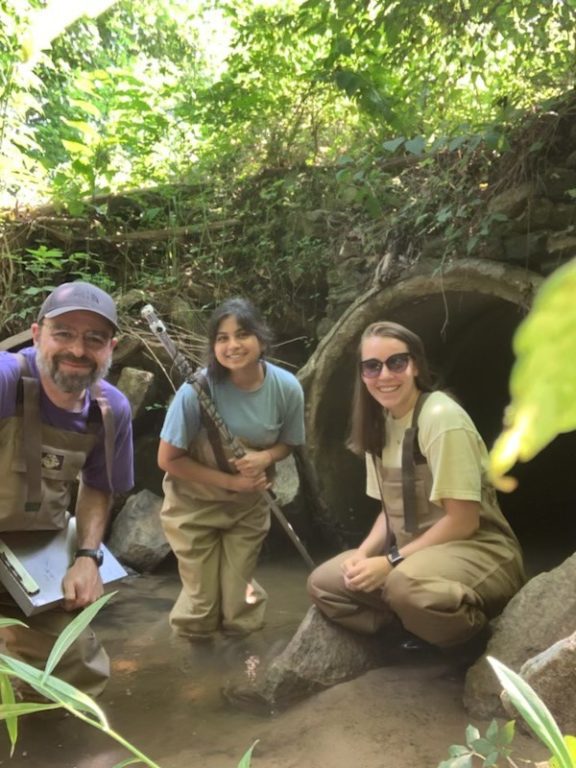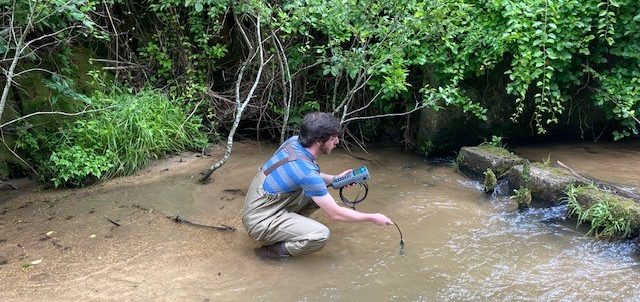By Amanda Cordle, August 2021
For many of us, when we turn on our faucet for a glass of cold water on a hot summer day, we don’t give much thought to where that water is coming from. If asked, we know about the water cycle and that waterways connect to larger bodies of water, but most days, we don’t consider the network of streams and rivers that allow for our day-to-day activities.
Dr. Greg Lewis and his student researchers, George NeCastro, Sonali Patel, and Krista Just, however, are different. Dr. Lewis has dedicated much of his professional research to studying the quality of various freshwater sources—with an emphasis on analyzing the impacts of anthropogenic pollutants from urban settings. Due to the importance of water across a number of scientific disciplines, Dr. Lewis enjoys collaborating with researchers from a variety of specialties.
Commenting on the interdisciplinary nature of his work, Dr. Lewis says, “I really enjoy that part…I’ve worked with a number of EESS [Earth, Environmental, and Sustainability Sciences] majors in the past and Biology majors who have been interested in everything from environmental biology to…medicine.”
This love of interdisciplinary research is a highlight of Dr. Lewis’ lab this summer. While George, Sonali, and Krista are working with him to study the broad research topic of freshwater quality, their specific research questions are catered toward their interests and post-graduation plans.
George, an EES major who hopes to be an environmental consultant, is focusing on the effect elevation plays on the chemical composition of streams and rivers in natural environments. In addition to Dr. Lewis, George is also working closely with Dr. Suresh Muthukrishnan from the EESS Department to complete this study.
With plans to attend medical school after Furman, Biology major Sonali Patel is researching the microbiological differences between urban and rural waterways and looking for bacteria that could indicate potential health risks to human populations.
Krista Just also hopes to attend medical school, as well as graduate school. Her research combines the ideas behind George’s and Sonali’s studies. She is researching the microbiological differences between water samples from different elevations.
Important Basics of Water Quality Research: Dr. Lewis’ Main Focus
One way in which Dr. Lewis studies the impact of various pollutants is through comparison studies between water sources in more natural settings and those found in urban areas.
It is important not to group agricultural land with natural land for these comparison studies because rural, agricultural areas are often pasture lands, and therefore have far more pollutants than natural, forested areas.
“Just because it’s rural,” Dr. Lewis says, “doesn’t necessarily mean it’s cleaner than urban areas.”
However, the sources of pollutants found in the rivers and streams of urban areas are often different than those found in rural, agricultural settings. One anthropogenic impact on urban waterways in certain parts of the world is an increase in calcium deposits from underground concrete pipes.
Similarly, leaking sewer pipes can also increase pollution in urban environments.
“In urban areas, you have sewer lines in much higher density, and as they age, sometimes they leak, not so much directly into the streams but through the groundwater that gets contaminated with nitrogen, or phosphorus, or fecal bacteria,” explains Dr. Lewis.
These three pollutants are also common in rural waterways. However, instead of deriving from aging sewage lines, their source is animal waste and fertilizers from farms. When it rains, groundwater carries these pollutants to nearby streams and rivers.
Streams and smaller rivers can receive excess nitrogen, phosphorus, and fecal bacteria and deliver them to downstream water bodies. In turn, lakes downstream are often faced with eutrophication and excess algal growth which can lead to hypoxic or even anoxic conditions.
In a similar manner, towns that are downstream of urban or agricultural areas often only have access to more heavily polluted water than the towns and cities upstream.
“Greenville itself is lucky because we get our drinking water from these really protected mountain, man-made lakes, but towns downstream like Greenwood or Laurens are drawing their drinking water directly from a river…and so there’s lower water quality for those downstream communities because of a big city that’s upstream,” Dr. Lewis explains.
Why Studying Elevation Matters: George’s Research
Instead of comparing water samples from natural and polluted sources, George NeCastro is researching the natural variations in water chemistry in rivers and streams found at different elevations across the South Carolina Piedmont and Blue Ridge Mountains. The results of his study will improve Dr. Lewis’ and other researchers’ ability to compare natural water sources with water sources contaminated with anthropogenic pollutants.
“The problem is,” Dr. Lewis explains, “there aren’t many forested [natural] areas that are at the same elevation as Greenville, so you either have to go to the mountains to find more forested areas or you have to go further south…and what we realize is that’s problematic because the water varies naturally in terms of the chemistry and the microbiology.”
George’s study will help future researchers distinguish between changes in water composition due to urban pollution and changes that are natural.
As an aspiring environmental consultant, and as someone particularly interested in hydrology, George is thoroughly enjoying this summer research.
“What we’ve done so far this summer has been a really great time,” George shares. “We’ve been doing a lot of fieldwork– going out and getting actual water samples and bringing them back to the lab.”
This fieldwork has been critical in helping George decipher where he would like to work in the future as well as which specific field of environmental consulting is right for him.
How Medicine and Water Quality Are Connected: Sonali and Krista’s Research
For many students interested in medical careers, working in an ecology and environmental science lab would seem too different from the medical world to justify dedicating one’s summer to researching topics such as water quality.
However, rising senior Sonali Patel has a different outlook on medicine.
“For me, medicine is more like an interdisciplinary field, so I really see medicine as being impacted by sociology, psychology, and the natural world, which is why I really wanted to do this research,” Sonali explains.
Instead of focusing on elevation or even pollutants as a whole, Sonali’s research focuses on the microbiology of different water samples from urban and rural settings. Studying microbiology enables her to discover potential human health risks within the water samples.
Similarly, fellow premed student Krista Just is researching the impact that elevation has on the microbiological content of the water. Krista is looking less at potential human health risks and more at how these organisms are impacting the environment.
Conducting summer research with Dr. Lewis is helping to prepare Krista for her post-college plans.
“I want to go to grad school before I go to med school to do further research, but more on something similar to Sonali’s track—more of a medical environmental focus,” Krista shares. “I think it would be really cool…to be a doctor that focuses on environmental health.”
Sonali also believes that working in a lab environment is better preparing her for medical school.
“Lab work is…very important,” She shares, “and working with a professor and other students is also a big part of medicine because it’s a collaborative effort.”

Looking Forward
While freshwater will remain the broad scope of research in Dr. Lewis’ lab for years to come, Dr. Lewis will continue to encourage students to make their projects their own. No matter one’s future
—be it medical school, environmental consulting, or any of the plethora of other careers in the sciences—there is something for everyone in Dr. Lewis’ lab.
“This is a project that reaches a lot of different disciplines, so there’s even more that can be done with this even after we’re done this summer,” George assures.
